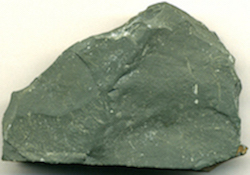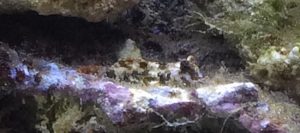
Rocks may not seem to do much, but in the aquarium they contribute to the ecosystem a great deal. Calcareous rocks in your aquarium raise pH and make your water “harder”; replicate marine habitat parameters. Rocks provide hiding places and breeding grounds for your fish, making them at home. Copepods, amphipods, and other micro-organism foods will cling to your rocks, which allows your fish to hunt and eat them. Algae will grow on your rocks so that if you have snails, crabs, shrimps, and other intertebrates, they will have a constant food source to fulfull their herbivore needs. Rocks can be structured into an aquascape, making plateaus, mountains, and decorations to transform your aquarium beautifully. Rocks near the top of your fish tank, closer to the aquarium lighting, will grow vibrant, astounding healthy algae of colors including light green, pink, red, and purple. As your tank ages, the colors will change, providing “seasons” in your fish tank. This makes your aquarium world really come to life! In marine tanks, rocks are essential to the saltwater habitat and ecosystem. In freshwater tanks, the pH and alkalinity buffering is not needed, but rocks will add fun and visual appeal to your fish tank. Read below to find out which rocks are the best for freshwater and marine aquariums.
Best Safe Freshwater Aquarium Rocks
Freshwater aquarium rocks should be inert, meaning they should have no affect on the pH or hardness of your fish tank water. Freshwater habitats are considered soft water, and adding the wrong rocks to your tank would sway your water to be hard; uncomfortable for your fish. An exception to where you can use calcareous rocks that do not contain salt is with African Cichlids and other hard water originating freshwater fish. The rocks type to stay away from is calcereous rocks; these rocks contain calcium and cause pH and hardness boosting in your water. If softer freshwater is desired, it is best to add clean wood which softens water. Inert rocks that look great in your freshwater tank are:
-
- Lava Rocks
-
- Shale or Slate
-
- Basalt Rocks
-
- Quartz
- Plastic Rocks
Aquarium rocks can cause harm to your fish and aquarium ecosystem if they are not cleaned before use. This is because dust, toxins, and harmful outside bacteria may reside on the rocks. If using pre-sterilized rocks from a pet store it is still recommended to brush them and soak them for at least one day to be sure they are completely dust and debris free. They may have gotten dirty by waiting on shelves or during shipping. If gathering rocks from nature, beware that there is always a risk. There is never a way to be one hundred percent sure that your rock will be completely clean, and it is unknown what kind of bacteria lives on the rocks. However, if taking rocks from nature, follow these steps to have the maximum fish tank safety possible:
Cleaning Rocks From Nature
-
- Identify the type of rock and make sure it is suitable for your fish; calcareous?
-
- Boil the rock in a pot for approximately 30 minutes to kill present, potentially harmful bacteria. If the rock is humongous, place it in a clean trash can or large plastic heat-safe tub and add new boiling water occasionally.
-
- Place the rock in a large container and leave it there for one week, scrubbing it with a stiff brush twice per day to ensure any harmful substances fall off your rocks.
- Test if your rock will crumble easily. Change the water and scrub the rock very hard. Leave the rock rest for a day, and if you see in a day that the rock crumbled, it will probably crumble in your tank. This means it should not be used because it can be harmful to your fish.
Lava Rocks
Lava rocks are formed when volcanic lava cools. Over seven hundred types of lava rock exists, so lava rocks in stores may vary slightly in color shades. Lava rocks may be black or gray, but the most commonly sold lava rock is a cross between red and orange. These rocks are durable, as volcanic lava cools into a hard substance. Lava rocks are very porous, so they are good for breeding healthy bacteria in your tank. Usually, lava rocks come with a hole or two that fish enjoy swimming through. Overall, lava rocks are appealing visually, tank healthy, and entertaining while you watch your fish swim through the rock’s holes. A great lava rock is as follows:
| Lava Rock |
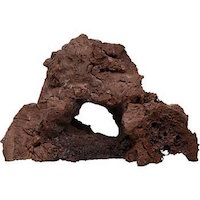 |
| View on Amazon |
Shale and Slate
Shale is a sedimentary rock composed mostly of clay, quartz, and calcite. This rock is usually long and thin, making it perfect for aquarium plateaus. This rock is hundreds of years old, and is very durable. Shale is perfect for aquascaping, and comes in a range of colors including black, gray, and purple.
Slate is a fine-grained metamorphic rock that is derived from shale. It is composed of mostly volcanic ash, quartz, and clay. Slate can be found colored in many shades of gray, green, purple, and cyan blue. Slate is very durable and like its counterpart shale, great for aquascaping as plateaus.
Both shale and slate can be found in many local fish stores, pre-sterilized. These rocks will be a great addition to any freshwater or marine tank.
Photo credit given to Flickr user James St. John.
Basalt
Basalt rocks are igneous, volcanic rocks formed from cooled lava. Basalt rocks are very dark, usually gray scale rocks. These rocks are very heavy and dense. Basalt rocks come in various shapes; squares, rectangles, circular stones. They come in all sizes, big and small. Basalt rocks do not cause pH buffering, so they are suitable for both freshwater and marine aquariums. Basalt rocks may be found in nature or at a local fish store near you.
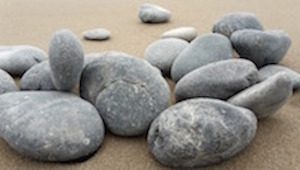
Quartz
Quartz is a beautiful, transparent crystal gem that resembles the appearance of diamonds. Quartz is inert; it will not alter your pH or water hardness. Quartz comes in a variety of colors; amethyst is purple, citrine is yellow, rose is pink, smoky is black, and milky is white. Quartz is aquarium safe and is a great addition for any tank that wants some bling and uniqueness.
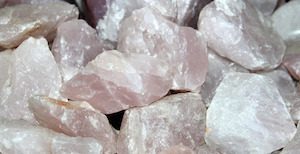
Plastic Aquarium Rocks
Plastic aquarium rocks are decorative rocks created to give aquariums a scenic look without the worry of rock finding and cleaning. These decorations come in many different forms; almost any rock you could think of. A positive aspect is that you can have any rock look you want; no need to worry if the rock type is suitable for your aquarium environment. The negative side is that you do not get the benefits of real rock look, texture, and bacteria growth. Decorative rocks may be found in your local fish store or on the internet easily.
| Decorative Shale Rock | Decorative Texas Holey Rock |
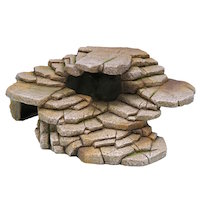 |
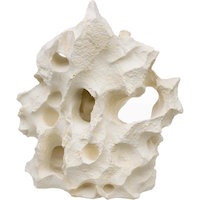 |
| View on Amazon | View on Amazon |
Best Safe Saltwater Aquarium Rocks
Saltwater aquarium rocks imitate oceans by being calcareous: they raise the pH and hardness of your water. In marine tanks this is great, because the fish species have originated from bodies of saltwater and prefer hard water. Calcareous rocks can be huge, and used to create reefscapes in your tank. Marine fish enjoy love reefscapes, and will hop about them excitedly. They will hide behind, eat micro-organisms off of, and play on these rocks. In a marine tank, the rule to abide by for optimum fish happiness is 1.5 pounds of rock per gallon of tank water. These precious beings came from the reef, and to appreciate them we can give them a reef of their own to make them at home. Great reef rocks include:
-
- Live Rocks
- Dried Reef Rocks and Petrified Coral
Live Rocks
Live rocks are aragonite skeletons of dead corals that are harvested from wild reefs originated in the Caribbean or Indo-Pacific locations. Live rock can be told apart from base coral rock because it is covered with coralline algae colored mostly pink, purple, green, and red. Live rock is “live” with millions of healthy bacteria for your aquarium. Live rock in your aquarium should follow the guidelines of 1 to 1.5 pounds of live rock per gallons of aquarium water for maximum healthy water parameter impact. This number can be slightly more or less depending on personal taste and style. Benefits of live rock in your aquarium are:
-
- Millions of bacteria live in the many crannies and crevices of your rocks and function as huge biological filters for your fish tank. They will convert the ammonia in your water into nitrite, then less toxic nitrate, and finally into harmless nitrogen gas. This keeps your water parameters stable and fish-friendly.
-
- Live rocks are calcareous, meaning they raise pH and the “hardness” of your water. This comforts your fish because it makes your aquarium adopt the feel of a real marine setting.
-
- Aquascaping your rocks provides coves, arches, hideaways, and ultimately homes for your fish. Your fish will enjoy having a “home” place, and many species such as clownfish will use their homeplace as a safe haven, breeding and sleeping in that location.
- Coralline algae growing various vibrant colors makes your aquarium lively and blooming with beauty. Your aquarium will light up your house, and be a major source of excitement and entertainment.
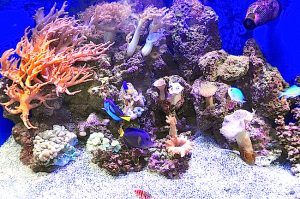
Photo credit given to Flickr user Moto “Club4AG” Mlwa.
Selecting live rock
Choosing live rock for your aquarium is based on appearances as well as best value and cleanliness. When purchasing live rocks at your local fish stores follow the below steps in order to choose the healthiest, most thriving rocks for your fish tank:
-
- Find appealing rocks colored purple, pink, and red as these are healthy, matured coralline algae colors. Avoid rocks with black algae or slimy texture on them as this is a sign of dead organisms and will contaminate your fish tank. Favor rocks of various shapes with holes and crevices in them to provide homes for your fish and good bacteria colonies. Check that the texture of the rocks is rough, as overly smooth textures may indicate fake live rocks. Choose lighter rocks over denser rocks because lighter rocks will be cheaper and give you the best price value for the size. Keep an aquascaping design in your mind when looking, as you will use these rock pieces to set up your aquarium display.
-
- Check the rocks for signs of living organisms. Great free and desired organisms that “hitchhike” on live rocks include mushroom corals, polyps, feather dusters, snails, and if desired, crabs. Organisms to avoid bringing home to you aquarium include aiptasia, a weedy coral that spreads like wild fire and steals tank nutrients, vermetid snails that come in hundreds usually and fill your tank with long, ugly webs that steal nutrients, and pest starfish and anemone.
- Smell your rocks. If the rock smells fishy or rotten they are not yet cured. This is no problem as you can cure your rocks easily, but it is necessary to know to ensure the safety of your aquarium livestock. Adding uncured rock would be vary harmful.
If there are no local fish stores near you selling live rock, or if you would prefer the ease of buying pre-picked live rock, Blue Life Aquatics offers a good deal of four dollars per pound of live rock rather than the usual five or six dollars:
| Blue Life Aquatics Live Rock |
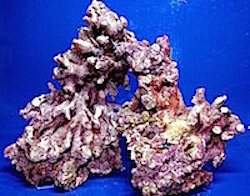 |
| View on Amazon |
Curing Live Rock Before Use
This guide is for curing aquarium rocks in an established tank; a tank that already contains livestock and corals:
-
- Place your live rocks in a large container such as a 5-gallon bucket or clean trashcan, in a low or no lighting area.
-
- Add clean de-chlorinated, or better yet, reverse osmosis saltwater to the bucket, filling it.
-
- Add a heater to the large container, and turn it to around 80 degrees. Add a power head or airstone to provide water movement so that dead bacteria can constantly be pushed off the rock. Do not add a light as lighting would cause unwanted algae bloom.
-
- Scrub the live rocks gently with a toothbrush or any other bristled brush a few times per week to remove dead organisms while keeping healthy organisms.
-
- Change the water with new, clean, de-chlorinated or reverse osmosis saltwater twice per week for maximum cleanliness.
- When the water no longer appears murky, check the ammonia and nitrite levels with a test kit. If a test kit is not owned, your local fish store such as Petco may provide one for free for you. When the ammonia and nitrite levels reach zero, your rock is cured and ready to place into your aquarium.
This guide is for curing aquarium rocks in a new tank; a tank that is not yet established and does not contain livestock or corals yet:
-
- Rinse your live rock in a 5-gallon bucket of clean, de-chlorinated or reverse osmosis saltwater to remove dirt, debris, and sand.
-
- Place your live rock into your setup aquarium, and aquascape it into a desired, appealing structure.
-
- Scrub the rocks gently a few times per week with a toothbrush to remove decaying organisms and debris.
-
- Change half your tank water every week and gravel-vac loose, dead materials at the bottom of your tank to keep the tank clean for healthy rock curing.
-
- Use a test kit owned or from a local pet store to check ammonia and nitrite levels once per week. When the tank is pretty clear and these levels are zero perform another half water change.
-
- After one day, check the water pH with a test kit to see that the pH level is between 8.1 to 8.4; desired pH level for marine ecosystems. If it is not and your water is no longer murky, add more rocks or pH boosters to your aquarium.
- Your aquarium rocks are now safe for fish, and your fish tank should be on its way to being cycled and safe to add livestock and corals to.
Dried Reef Rock and Petrified Coral
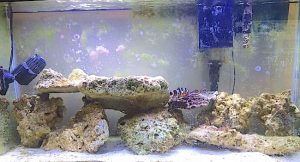
Dried reef rocks are essentially live rocks that are dead of bacteria and organisms. Dried reef rocks are composed of dead coral from reefs. These rocks are usually white to tan in color; no colorful coralline algae like on live rocks. These rocks are great for making aquascape structues for your fish to live in, hide in, and enjoy.
Petrified coral is coral that is dried and no longer houses living organisms or bacteria. Usually this type is coral is seen as white to tan branches. Petrified coral is great for adding unique features to your aquarium aquascape.
Both dried reef rock and petrified coral can be made “live” with bacteria and organisms with time and a healthy, thriving aquarium. A newly established tank may take years to gain large quantities of coralline algae and bacteria blooms because the tank ecosystem is new and must mature and gain stability to maintain small, delicate organisms such as copepods and various bacteria. The process of turning dried rock and coral “live” can be sped up by adding rocks, sand, and other objects to a newly established aquarium from an established, older aquarium. This way, the massive coralline algae and bacteria will spread onto your new rock and coral and house themselves there. Before adding dried rock and coral to your tank it is advised to cure them incase they have harmful dust or toxins residing on them from store handling. Proper curing method can be found above; “Curing Live Rock Before Use”, but for a shorter duration of time. Dried rock and coral can be obtained at local fish stores or online for decent pricing. Great dried reef rock is sold by trustworthy Carib Sea. These rocks are white and shaped gorgeously, as well as having a cheap price of less than two dollars per pound:
| Carib Sea Dried Reef Rock |
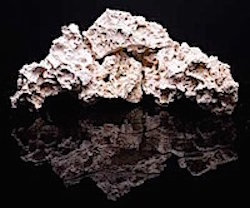 |
| View on Amazon |
